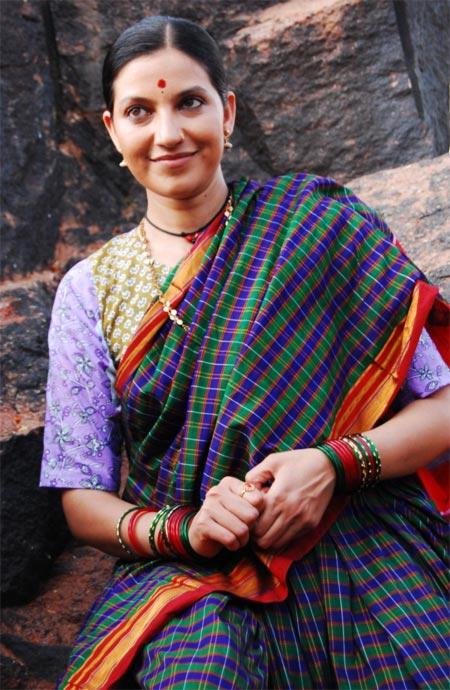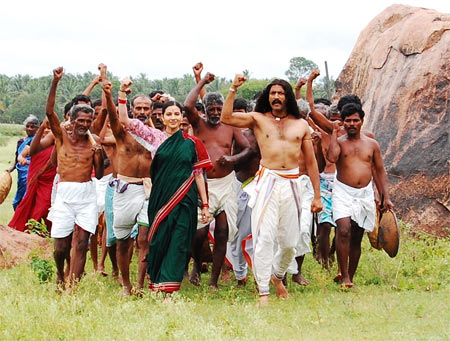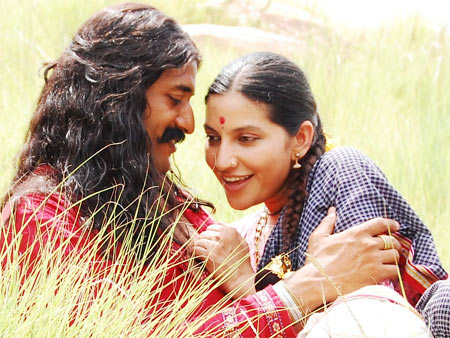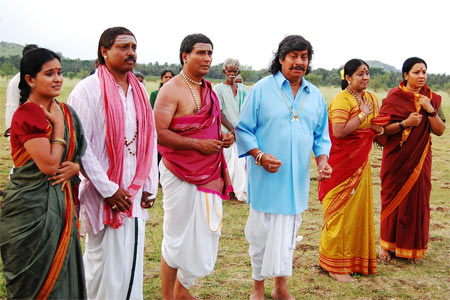 | « Back to article | Print this article |
'Bhageerathi is about a woman's forced sacrifice'
Kannada writer and filmmaker Baragur Ramachandrappa's latest Kannada film Bhageerathi, that hit the screens last week, has received a lot of critical acclaimed.
Prof Baragur, as he is known in Kannada literary circles, has worked on a popular five-page folklore ballad Kerege Haara (symbolic meaning food for the lake) for this his latest Kannada film that turns the spotlight on a woman who is forced to sacrifice her life for the welfare of her village and community.
In this interview with Srikanth Srinivasa, Baragur Ramachandrappa talks about Bhageerathi and the response that the film is drawing.
What have you tried to convey through this film?
The film talks about the dilemma faced by the protagonist Bhageerathi and her father-in-law, Mallanna Gowda, who is advised to sacrifice one of his daughters-in-law for the community.
Gowda has built a tank for the village, but it remains dry although it is not due to lack of rainfall.
There are three or four similar folklore ballads based on the lakes and the sacrifices that are made to save the lake and the community at large. There are different regional interpretations and details in every story.
'Adapting a five-page ballad for a film was really challenging'
Why did you choose a ballad as a subject for a full length feature film?
This subject has been at the back of my mind for the last seven or eight years.
I worked on the script as I felt that popular folklore needs to be recreated. Without sacrificing the central theme of the folklore ballad, I tried to reinterpret Kerege Haara.
When I first read this ballad, I did not see this as a story of sacrifice of Bhageerathi.
There are superstitions and blind beliefs but there is no mention of any sacrifice even in the original.
When we talk about sacrifice, a woman has to willingly take the plunge. But I felt that Bhageerathi was unwilling to let go of her life. She is perturbed and confused about her next move after she overhears that she is to become the sacrificial goat to save the tank.
What were the challenges in adapting a five-page ballad for a film?
It was really challenging. I had got the essence of the story but I had to make a 135-minute film, and not compromise on the central theme.
I had to take small threads in the folklore and weave them into a story and make it a part of my narrative, which was daunting.
I did not want to impose my views but I had to reinterpret and recreate the theme, which was another challenge.
'I am not someone who rejects tradition'
What was your intention in turning your attention to the state of lakes or the vanishing lakes in our milieu?
Lakes are the lifeline of all villages. Today, lakes are vanishing because they are filled with silt and are not cleaned.
The story turns the spotlight on lakes and on why they should give livelihood and life to the villagers and not take away lives of villagers. Bhageerathi gives up her life rather inevitably and under duress. There's another interesting observation: People who decide that a woman's life should be sacrificed to save the lake and the community never ever communicated this decision to the woman because they are unable to do so.
There are no villains in the film and the father-in-law, Gowda, is not a villain as some people have interpreted. He is never able to communicate this decision to his daughter-in-law.
How is it that you chose a subject that talks about superstitions and beliefs that you have strongly rejected in your literary works?
I am interested in reinterpretation of some of the beliefs. I am not someone who rejects tradition; our traditions are dynamic in nature.
Convention is different from tradition as the former is stagnant in our society. Some traditions are accepted and some others are rejected. Our traditions have radical thoughts.
I have reinterpreted the Ramayana and Mahabharata and evaluated the values that they convey so as to suit the requirements of today.
The same thought applied to Kerege Haara. Today, female sensibilities are gaining currency and value and I thought this subject tried to find an answer to such questions.
This film is also an effort to do justice to the misgivings that existed about some characters in the film, especially that of Mallanna Gowda.
This is not opposed to my radical approach. We should also understand that we cannot reject some of our puranas (old stories) and traditions but they can be reinterpreted.
'The film's theme is relevant even today'
How relevant is it today?
Nobody knows the period as the names of kings and queens are never mentioned, but this film does not belong to the twentieth century.
However, it is relevant even to this day as a woman's life should not be taken away because of ignorance. The film also talks about the importance of lakes and how they protect our environment. The lake is used as a metaphor in the narrative.
Bhageerathi wants a tank and she falls in love and gets married in the tank, and finally falls prey to the lake, which is such an irony.
Why did you go with this title?
Bhageerathi is the name of the character in the ballad. It is also the name of the river, and it signifies the purity of a woman.
When I work on a script, I visualise within my circle of known people if anyone can fit into the role.
'I have ensured that the film reaches the nooks and corners of the state'
Why did you cast Bhavana for the title role?
Bhavana had worked with me in two of my earlier films -- Kshaama (famine) and Shanti -- and the former had even won her an award while the latter made an entry into the Guinness Book of Records.
If they are not suitable or available, I look out for others. Kishore, a popular villain, was my student and I think he is talented.
How do you intend to promote Bhageerathi? Will you exhibit it in remote villages as you have your earlier films?
We had conducted a Chitra Yatre for 100 days for five of my earlier films that were exhibited in remote villages across Karnataka. Tickets are sold in advance through associations and friends.
We have screened my films in touring talkies. I have ensured that the film reaches the nooks and corners of the state.
The response was quite good as it was an alternative form of release. We reached out to the people, which is the reverse of people flocking to the theatres.




